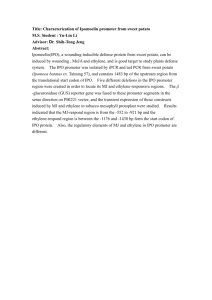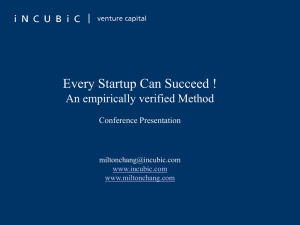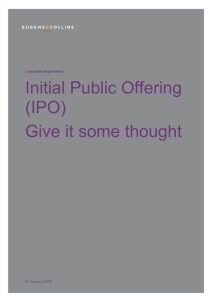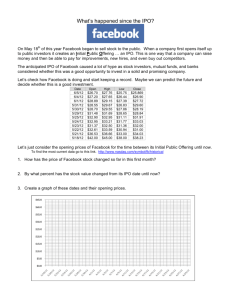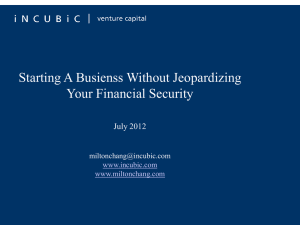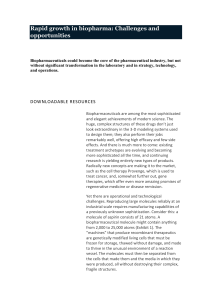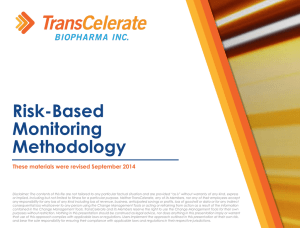The PLIPO Business Model - Financial Institutions for Innovation and
advertisement
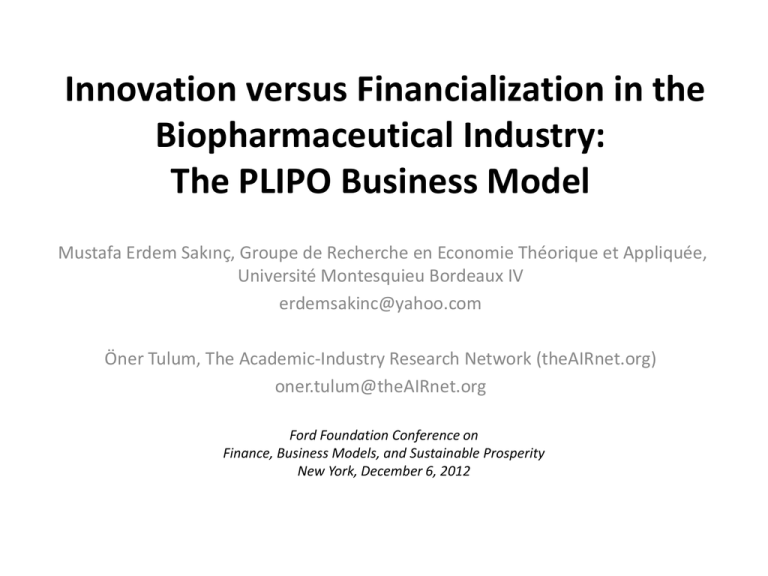
Innovation versus Financialization in the Biopharmaceutical Industry: The PLIPO Business Model Mustafa Erdem Sakınҫ, Groupe de Recherche en Economie Théorique et Appliquée, Université Montesquieu Bordeaux IV erdemsakinc@yahoo.com Öner Tulum, The Academic-Industry Research Network (theAIRnet.org) oner.tulum@theAIRnet.org Ford Foundation Conference on Finance, Business Models, and Sustainable Prosperity New York, December 6, 2012 I - OVERVIEW • Biopharma is one of the few industries that has been successfully generating funding for innovation for decades – Successfully generated funding in the form of VC, R&D partnership, M&A, public issuance and etc. – Exponential growth between 1990-2008 • Formation of development stage companies with no product/product revenue, and with less than 100 employees • However, biopharma overall displays relatively poor performance – Industry overall has yet to generate profit – And relatively very few successful drugs came out given the size of the money invested • Why have venture capitalists, big pharma, and public investors been investing so heavily in an industry in which profits are so difficult to generate? (Lazonick & Tulum 2011) II- the PLIPO Business Model • • • • Given how complex, protracted (10 years+) and expensive (≈$US2-bn) the product development process is, long term patient capital commitment is required BUT; Many development stage SMEs without any positive income figures and without any commercial products seek to go for an initial public offering (IPO) only a couple of years after inception We call these firms “PLIPOs”, or, productless companies that have done an IPO Why does PLIPO occur? – Major discoveries based on decades of NIH support on R&D activities has supplied the industry viable technologies for further development, – VC industry recognized the potential value and applies the Silicon Valley model on biopharma – NASDAQ provides the liquidity investors seek – Legislative changes on IP (Bayh & Dole, Chakrabarty v. Diamond Supreme Court Decision) National Institutes of Health budgets 1938-2011 Total NIH spending, 1936-2011 in 2011 dollars=$792 billion NIH budget for 2012=$30.9 billion Source: http://officeofbudget.od.nih.gov/approp_hist.html VC Investment & VC Backed Deals 1972-2012 VC Backed IPOs 1980-2012 How Does a PLIPO Work? • PLIPO companies are often founded in collaboration with university researchers initially funded by public grants • NIH and other government funding of basic and preclinical research have been the major sources of funding for early stage drug development. • Despite the availability of public support, when these scientists decide to form a company they still need more financial resources, • The blockbuster drugs that big biotech commercialized both underwrote their continued existence and lent credibility to the PLIPO model. • Lured by the prospect of a quick PLIPO exit on NASDAQ, VC has usually been the suppliers of equity finance anywhere from seed stage and pre-clinical phase • Longevity of product development process allows market speculation to take place based on “real news” or “events” (milestones, FDA reviews, etc.), speculative investors draw to this feature (ie. Human Genome news during the dotcom era drove the prices overall) Methodology • The study is built upon researchers’ prior work, Lazonick & Tulum (2011) and Lazonick & Sakinc (2010) • An empirical study utilizes: – Descriptive analysis based on the secondary data gathered from various sources – Case study approach through building cases on biopharma • Understanding the effects of the current finance model on the industry’s innovation productivity requires a firm level focus • Constructing a longitudinal database will allow us to trace the companies historically, and by doing so we can conduct firm level analysis on selective company case studies to see how the companies have done overtime CURRENT DATASET • We have constructed a dataset of active public biopharma companies that are currently developing or producing therapeutic drugs, and that have secured funding in NASDAQ between 2000 and 2012. • The dataset has been populated by combining data from Thomson Reuters Venture Xpert and NASDAQ historical records • Dataset has been refined to 87 active biopharma companies that are operating in the U.S. • Companies’ financial, R&D, product pipeline, and demographic information have been gathered from various SEC documents and financial reports such as 10-K, S-1, company proxies and various other legal documents. • Product approval data has been gathered from FDA Orange Book and orphan drug data has been gathered from FDA Orphan Drug Database. Database Highlights • An average of 6.5 years from Incorporation to IPO, and ranges from anywhere from 0.4 to 22.3 years • 61.9 full-time employees at the time of IPO, 119 employees per company average (up 92%) as of 2011, • Per company average products in the pipeline went up to 5.4 from 4.6 (up 18%) • Only 8 companies (10% of total) had at least 1 marketed product at the time of IPO. Currently this number is up to 24 companies (%31 of total) with a total of 35 marketed products, • In 2011, total generated revenue of these 87 company is $US3.2 while the product revenues is only $US1.4bn. Net Income is -$US3.3bn and R&D expense total is $US3.4bn, • 37 companies in the dataset have a total of 75 orphan designated product candidates, and 9 (out of 35 marketed) products have been granted marketing exclusivity • It is an average of 10.4 years from inception, and 5.7 from the date of IPO that has taken for the companies in the dataset to get FDA approval Productless IPOs Pre- & Post-IPO Comparison Pipeline Comparison Distribution of companies’ incorporation and IPO years Source: NASDAQ Composite and Biotech Index data is downloaded from Yahoo! Finance. Pace of IPOs and Employment Change CASE STUDIES • Pharmacyclics – Founded in 1991 (Sunnyvale) by scientists with in-licenses from UT and went public in 1995 – Critical support of NCI in the early period – Major source of finance: secondary offerings (11 times in the last 16 years after its IPO) – Repeated failures of drugs in late-stage Phase III – Restructuring in 2008 with new executives and new product candidates – NASDAQ notification in 2009 – Rise and fall of employment (re-rise in 2012) – Continuous stock purchase of current CEO until 2011 within a price range of $1 to $9. Currently the stock price is around $55 – Collaboration with Janssen Biotech (J&J) which brought the only significant revenue in the 21 year history of the firm – As of December 2012 the most advanced drug candidate is in Phase II – Highly fluctuated ownership structure due to hedge funds 30 a 25 Series1 Series2 Series3 Series4 Series5 Series6 Series7 20 Series8 Series9 Series10 Series11 Series12 Series13 Series14 15 Series15 Series16 Series17 Series18 Series19 Series20 Series21 Series22 10 Series23 Series24 Series25 Series26 Series27 Series28 Series29 5 0 Series30 15 b 12 Series3 Series6 9 Series10 Series12 Series15 Series16 Series17 Series18 Series19 Series20 Series21 6 Series23 Series25 Series26 3 0 CASE STUDIES • Esperion Therapeuctics – Founded in 1998 (Ann Arbor) by scientists with a license of a single compound from Pharmacia&Upjohn – IPO in 2000 without any clinical stage drug candidate – Major source of finance: secondary offerings until the acquisition by Pfizer with $1.3 billion in 2004 after a big jump in stock price – Cancellation of Esperion’s program in 2007 by Pfizer and liquidation of Esperion – Restart in 2008 by same founder with VC investment and a single compound reverse licensing from Pfizer – Outsourcing and staying small strategy (only 15 employees as of November 2012 although it has a Phase II level drug candidate) DISCUSSION • • • • • • Steady rate of BLA approvals since mid 1990s when the biopharma rush began cashing in on the low hanging fruits of 1980s publicly subsidized R&D The blockbuster business model and the rapid rise in blockbuster revenues. Yet, there are only two new biological blockbusters in the last five years and a substantial decrease in the rate of increase of BB sales with continuing losses of patent protection Rising costs of commercial drugs for the society (drugs cost twice as much or more in the US as they do in any other country) Where the money goes: More stock buybacks and more executive compensation in the form of stock options of big pharma and biopharma companies. Persisting efforts of the US government to support biomedical research through NIH which is adopting a more radical and proactive approach in biomedical innovation through deploying new resources for late-stage clinical research and trials. Research into the validity of the financialization hypothesis and its implications for productive investment in the drug development process addresses a major social concern Thank you for your attention


